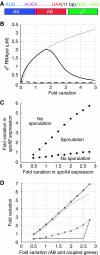A quantitative study of the benefits of co-regulation using the spoIIA operon as an example
- PMID: 16924264
- PMCID: PMC1681516
- DOI: 10.1038/msb4100084
A quantitative study of the benefits of co-regulation using the spoIIA operon as an example
Abstract
The distribution of most genes is not random, and functionally linked genes are often found in clusters. Several theories have been put forward to explain the emergence and persistence of operons in bacteria. Careful analysis of genomic data favours the co-regulation model, where gene organization into operons is driven by the benefits of coordinated gene expression and regulation. Direct evidence that coexpression increases the individual's fitness enough to ensure operon formation and maintenance is, however, still lacking. Here, a previously described quantitative model of the network that controls the transcription factor sigma(F) during sporulation in Bacillus subtilis is employed to quantify the benefits arising from both organization of the sporulation genes into the spoIIA operon and from translational coupling. The analysis shows that operon organization, together with translational coupling, is important because of the inherent stochastic nature of gene expression, which skews the ratios between protein concentrations in the absence of co-regulation. The predicted impact of different forms of gene regulation on fitness and survival agrees quantitatively with published sporulation efficiencies.
Figures



References
-
- Adhin MR, van Duin J (1990) Scanning model for translational reinitiation in eubacteria. J Mol Biol 213: 811–818 - PubMed
-
- Arigoni F, Pogliano K, Webb C, Stragier P, Losick R (1995) Localization of protein implicated in establishment of cell type to sites of asymmetric division. Science 270: 637–640 - PubMed
-
- Ben-Yehuda S, Losick R (2002) Asymmetric cell division in B. subtilis involves a spirallike intermediate of the cytokinetic protein FtsZ. Cell 109: 257–266 - PubMed
-
- Dandekar T, Snel B, Huynen M, Bork P (1998) Conservation of gene order: a fingerprint of proteins that physically interact. Trends Biochem Sci 23: 324–328 - PubMed
-
- Duncan L, Alper S, Arigoni F, Losick R, Stragier P (1995) Activation of cell-specific transcription by a serine phosphatase at the site of asymmetric division. Science 270: 641–644 - PubMed
Publication types
MeSH terms
Substances
LinkOut - more resources
Full Text Sources
Other Literature Sources

